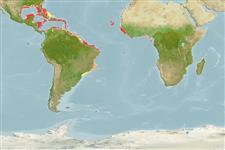Common names from other countries
>
Mulliformes (Goatfishes) >
Mullidae (Goatfishes)
Etymology: Mulloidichthys: Latin, mullus = soft + Greek, ichthys = fish (Ref. 45335).
More on author: Cuvier.
Environment: milieu / climate zone / depth range / distribution range
Ecologia
marinhas associadas(os) a recifes; intervalo de profundidade 0 - 49 m (Ref. 9710), usually 0 - 35 m (Ref. 40849). Subtropical; 33°N - 26°S, 98°W - 8°E
Western Atlantic: Bermuda and Florida, USA to Brazil, including the Gulf of Mexico and the Caribbean Sea (Ref. 9626). Eastern Atlantic: single record from Ile de Sào Tiago, Baie de Tarrafal, Cape Verde (Ref. 7313). Reported from São Tomé Island (Ref. 34088).
Length at first maturity / Tamanho / Peso / Idade
Maturity: Lm 17.0 range ? - ? cm
Max length : 44.8 cm TL macho/indeterminado; (Ref. 104752); common length : 28.0 cm TL macho/indeterminado; (Ref. 3792)
Espinhos dorsais (total) : 9; Raios dorsais moles (total) : 8; Espinhos anais: 2; Raios anais moles: 6. Body pale tan with distinctive yellow stripe from eye to caudal fin; tail yellow. Less brightly colored than other species and is the only one with a single yellow stripe along side (Ref. 26938).
Found over sandy areas of lagoon and seaward reefs (Ref. 9710). Often in schools (Ref. 26938). Forms schools with the smallmouth grunt (Haemulon chrysargyreum), an association regarded as social protective mimicry (Ref. 52492). Juveniles are common in seagrass beds (Ref. 9710). Feeds on benthic invertebrates (Ref. 7313). Marketed fresh (Ref. 3792).
Life cycle and mating behavior
Maturities | Reprodução | Spawnings | Egg(s) | Fecundities | Larvas
Robins, C.R. and G.C. Ray, 1986. A field guide to Atlantic coast fishes of North America. Houghton Mifflin Company, Boston, U.S.A. 354 p. (Ref. 7251)
Categoria na Lista Vermelha da IUCN (Ref. 130435)
CITES (Ref. 128078)
Not Evaluated
Ameaça para o homem
Reports of ciguatera poisoning (Ref. 30303)
Utilização humana
Pescarias: pouco comercial
Ferramentas
Relatórios especiais
Descarregue XML
Fontes da internet
Estimates based on models
Preferred temperature (Ref.
115969): 23.4 - 28, mean 26.6 (based on 720 cells).
Phylogenetic diversity index (Ref.
82804): PD
50 = 0.5078 [Uniqueness, from 0.5 = low to 2.0 = high].
Bayesian length-weight: a=0.01047 (0.00920 - 0.01192), b=3.10 (3.06 - 3.14), in cm Total Length, based on LWR estimates for this species (Ref.
93245).
Nível Trófico (Ref.
69278): 3.2 ±0.1 se; based on diet studies.
Resiliência (Ref.
120179): Médio, tempo mínimo de duplicação da população 1,4 - 4,4 anos (Preliminary K or Fecundity.).
Fishing Vulnerability (Ref.
59153): Low to moderate vulnerability (35 of 100).
